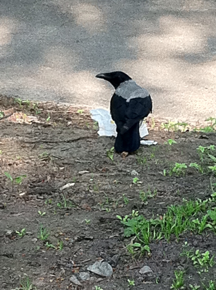Another couple of weeks in a downtown city with a potential handful of species sitting of nearby building which turned into something much better. the trip into the city found the (seemingly normal 'feeling' now) Hooded Crows in numbers but only a single Jackdaw. The following list of species and estimated counts were picked up largely in the local 'old' Botanical gardens a few blocks away from the Hotel.
The Gardens were a fascinating place.There are many Red Squirrels, seeming very used to interacting with the public and many of them, apart from the stream of commuters taking a shortcut, spent time interacting with the wildlife. The squirrels are a huge hit, locals calling squirrels by knocking nuts together and calling them.
I stumbled across some impromptu feeders made of an old plastic bottle and nailing wired food (fat blocks and bread) to a nearby tree. Locals would often come along and add a little food to the communal stash. And to huge effect....
Mallard (Anas platyrhynchos) 1 on the river from the lookup under the arch
Rock Pigeon (Columba livia) 100, probably many more, all over the city but almost always a group under the feeders picking up the scraps
Common Wood-Pigeon (Columba palumbus) 4 arounf the Botanic Gardens (BG)
Rose-ringed Parakeet (Psittacula krameri) 1, at least one bird coming regularly to the feeder in BG
Common Swift (Apus apus) 6, over BG on the last day. Maybe new arrivals but it was the longest i had spent out and latest in the day.
Middle Spotted Woodpecker (Dendrocopos medius) 1, at least one bird coming regularly to the feedeing station. Initial tomthe fat but also to the bread and seed. Amost always closely followed by.
Great Spotted Woodpecker (Dendrocopos major) 1, a female almost always asserting its larger size over the MSW
Eurasian Jay (Garrulus glandarius) 4, around BG
Eurasian Magpie (Pica pica) 6, around BG and a few flying around the city
Eurasian Jackdaw (Corvus monedula) 1, near the airport
Hooded Crow (Corvus cornix) 200, the common crow arounf the city and common around BG. Often found raiding the rubbish buns and relatively tame
Great Tit (Parus major) 30, common around the BG, very tame
Eurasian Blue Tit (Cyanistes caeruleus) 20, rather fewer than its bigger relative around BG
Eurasian Nuthatch (Sitta europaea) 5 White breasted European race,
Common Chiffchaff (Phylloscopus collybita) 3, singing around BG but sounding slightly 'off'
Wood Warbler (Phylloscopus sibilatrix) 3, probably three different birds at differnt sites around BG, one bird watched closely showed only a slight yellow wash the the throat and momentarily caused confusion until it reacted very strongly to wood warbler song. Before each trilling song, the clear, pure double note call was seen
Blackcap (Sylvia atricapilla) 2, two singing near the feeders
European Robin (Erithacus rubecula) 5, singing in the BG and the park opposite the Red building of the university
Eurasian Blackbird (Turdus merula) 4, several singing and seen around BG and the park
Fieldfare (Turdus pilaris) 20 Display flight and call in the BG, also birds singinging in the park. Although obviously a thrush call and song it was unfamilar and caused confusion until the culpret was found
European Starling (Sturnus vulgaris) 10, a few around the city and BG
White Wagtail (Motacilla alba) 1, one over the city
Common Chaffinch (Fringilla coelebs) 5, around BG
European Greenfinch (Chloris chloris) 30, around the city including BG. Birds singing along the Tarasa Chevchenka Boulevard
House Sparrow (Passer domesticus) 75, around the city
Eurasian Tree Sparrow (Passer montanus) 40, only seen in BG but common there and frequent,y at the feeder
















